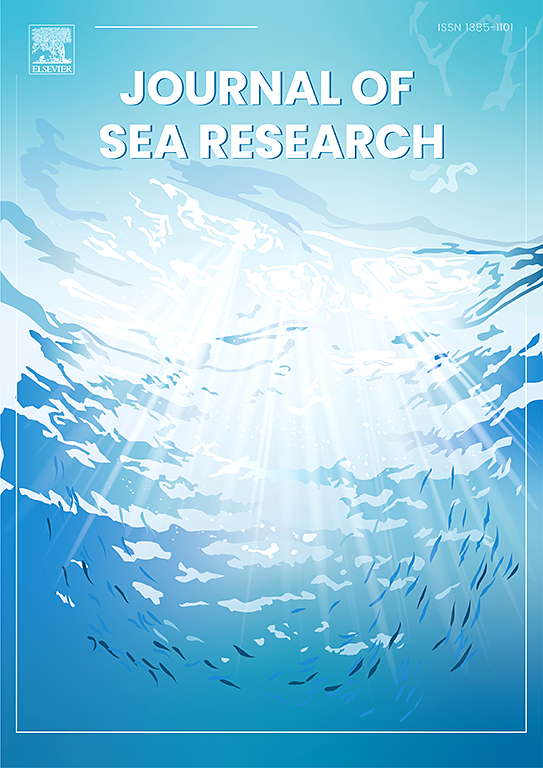波罗的海德国水域北极岛海洋圆蛤的近期分布和种群结构(林奈,1767)——生态学见解和保护的相关性
IF 2.9
4区 地球科学
Q2 MARINE & FRESHWATER BIOLOGY
引用次数: 0
摘要
北极岛(arctic islandica)是一种长寿的双壳类物种,其南部分布极限在波罗的海,在那里它在底栖生态系统功能中起着关键作用。在该地区,该物种被列为易危物种,其主要相关生物群落处于极度濒危状态。尽管其具有重要的生态意义,但目前对其在这一边缘环境中的分布和种群结构的了解仍然有限。本研究结合物种分布模型(SDM)和种群结构的经验数据,对波罗的海德国水域的岛沙蚤进行了迄今为止最全面的评估。利用随机森林算法和2015年至2024年间收集的底栖生物调查数据,我们绘制了丰度和生物量的空间格局,并分析了大小频率分布,以评估人口趋势。北极岛屿主要存在于基尔湾中部和梅克伦堡湾盐斜以下的细粒沉积物中,而在较浅的沿海地带(<10 m)则不存在。记录的最大外壳长度为82.5毫米,比大西洋种群小,可能是由于咸淡环境。尺寸频率数据表明,最近的招募事件与高早期死亡率同时发生。虽然波罗的海的种群数量大致稳定,但区域变化很明显-例如,Arkona盆地的种群生物量增加,但l本文章由计算机程序翻译,如有差异,请以英文原文为准。
Recent distribution and population structure of the ocean quahog, Arctica islandica (Linnaeus, 1767), in the German waters of the Baltic Sea – Ecological insights and relevance for conservation
Arctica islandica, a long-lived bivalve species, reaches its southern distribution limit in the Baltic Sea, where it plays a key role in benthic ecosystem functioning. In this region, the species is listed as vulnerable, and its main associated biotope holds critically endangered status. Despite its ecological importance, current knowledge of its distribution and population structure in this marginal environment has remained limited.
This study presents the most comprehensive assessment to date of A. islandica in the German waters of the Baltic Sea, integrating species distribution modelling (SDM) with empirical data on population structure. Using Random Forest algorithms and benthic survey data collected between 2015 and 2024, we mapped spatial patterns of abundance and biomass and analysed size-frequency distributions to assess demographic trends.
Arctica islandica was primarily found in fine sediments below the halocline in the central Kiel Bay and the Bay of Mecklenburg, and was absent from shallower coastal zones (<10 m). The recorded maximum shell length of 82.5 mm was smaller than in Atlantic populations, likely due to the brackish conditions. Size-frequency data indicated recent recruitment events alongside high early-life mortality. While the Baltic Sea population appears broadly stable, regional shifts were evident – for example, increased stock biomass in the Arkona Basin but also a population decline in Lübeck Bay.
In the Baltic Sea, A. islandica lives near its physiological tolerance limits, making it particularly susceptible to anthropogenic impacts and climate-driven environmental change. Population hotspots within the Marine Protected Area “Fehmarn Belt” were identified as conservation priorities, supporting both species protection and ecosystem functioning. More broadly, this study demonstrates the utility of SDM in supporting evidence-based marine spatial planning and targeted environmental management.
求助全文
通过发布文献求助,成功后即可免费获取论文全文。
去求助
来源期刊

Journal of Sea Research
地学-海洋学
CiteScore
3.20
自引率
5.00%
发文量
86
审稿时长
6-12 weeks
期刊介绍:
The Journal of Sea Research is an international and multidisciplinary periodical on marine research, with an emphasis on the functioning of marine ecosystems in coastal and shelf seas, including intertidal, estuarine and brackish environments. As several subdisciplines add to this aim, manuscripts are welcome from the fields of marine biology, marine chemistry, marine sedimentology and physical oceanography, provided they add to the understanding of ecosystem processes.
 求助内容:
求助内容: 应助结果提醒方式:
应助结果提醒方式:


